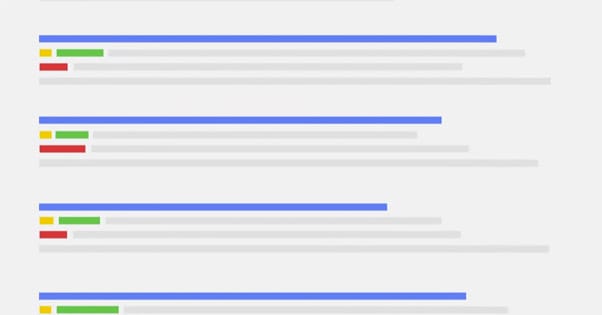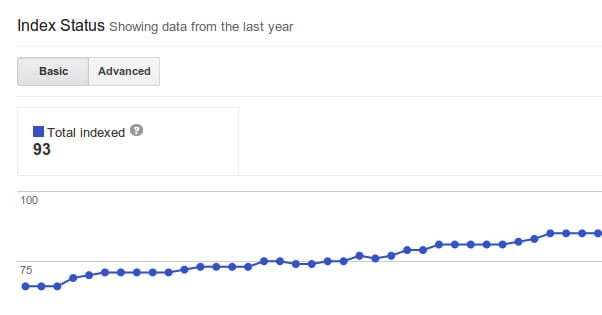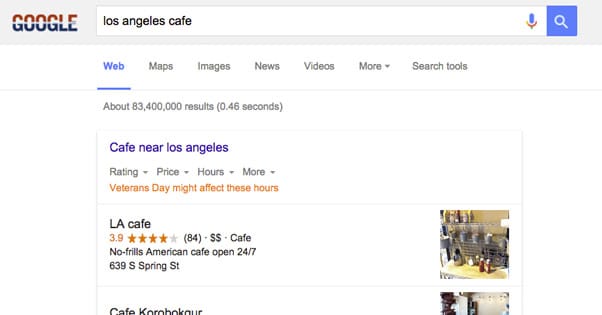How Long Does it Take to Rank a New Company Blog?
Published by Kenny Novak • Search Engine Optimization • Posted November 13, 2015 ContentPowered.com
ContentPowered.com
There’s a certain cycle of life online. Newcomers create new sites and new blogs. Businesses come in to spice up their old, lackluster websites with blogs. New companies spring up, running blogs to pitch their content. Black hats set up a handful of new spammy blogs every day. All of this is happening on a constant basis.
Add to that every website that updates every day and you get an idea of how much content is published on a daily, or even on an hourly basis. Then you have Google at the center of it all, the go-to resource for finding all of this new content. An individual website waits for Google to index their content, but if it takes too long, they get angry. “It’s just one blog post, how long can it possibly take?”
Well, when you consider that Google – one singular entity, no matter how large it is – has to index millions of pieces of new content, and all of the changes made to old content, every single day, you start to realize; it’s one hell of a big job.
How does Google manage it? Well, they have a massive fleet of powerful pieces of software called crawlers or spiders. These bots travel the web, starting from locations chosen by Google through some algorithm they have carefully worked out over the years. They compare existing content to what Google already has in the index. If the content is new or it has changed, Google makes an update to the Index. The bot then crawls along, following links and visiting other sites.
How long does it take for a single webpage on your site to load? Ideally, less than a second. That’s all the time Google’s bots need to load and compare the content. They never stay on a single page for more than a couple seconds, because they have no need to do so.
That’s how Google looks for changes, and how they find new sites when they have links, but what about brand new sites? Well, let’s look at how Google indexes sites in general.
- A link leading to a page that has changed or that they have not seen before allows them to index that page.
- A ping direct to Google allows them to see a new page and puts it in a queue to index it.
- A sitemap uploaded to Google will allow them to see every page on your site you want indexed, as well as giving them a convenient list of change dates so they can safely ignore pages that haven’t changed since the last time they checked.
- A page shared on Google+ gives them notice that a new page exists, if it’s not a page they have already indexed.
- Pages linked to Feedburner for RSS will get another method for indexation, though by that point you should have been indexed in other ways.
- Linking a new site to Google Analytics will give them notice that the site exists and will allow them to crawl it.
So, with all of those methods, what process should you use to get a new site indexed?
Getting a New Company Blog Indexed
Before I give you a specific process, I should make a note here. What I’m talking about is specifically for new sites as a whole. Do not do all of this just for a single new page. If that new page is incredibly important, you can ping Google with the URL, but even then it’s probably unnecessary.
Once Google has your site in the index, they will routinely check for changes, and any new content will be indexed quickly. It’s only when you’re building a new site with no backlinks and no previous presence that you need to dig into these strategies.
- Submit your site’s root domain – your homepage – to Google via the URL submission menu. You can find it here.
- Link your site via Google Webmaster Tools and install Google Analytics. This verification process puts you on the list for indexation.
- Create and upload an XML sitemap. You can upload the sitemap directly through Google Webmaster Tools. This will allow Google to see a complete list of all of the content on your site, so they don’t have to crawl links and try to find pages on your site organically. You can find the submission link in Webmaster Tools under Optimization, there is a Sitemaps option. As for making the sitemap, there are dozens of tools and plugins you can use; just pick your favorite.
These three steps alone should be enough to get you indexed fairly quickly. However, there are other steps you can use to supplement the process.
- Set up Feedburner for RSS. Now, I don’t normally recommend this. It’s a pain to migrate away from Feedburner if you want a more robust RSS feed. However, if you don’t really care about RSS and just want to use it to poke Google, you can use Feedburner just fine.
- Start sharing your site on social media. Google pays the most attention to Google+, but they will notice if you’re linked prominently from Facebook, Twitter, or another network.
- Submit your site to a few relevant, high quality blog directories. Do NOT under any circumstances use one of those “submits to 1,000+ directories” services or apps. This will look like you’re spamming your link everywhere. Sure, you’ll be indexed quickly, but you’ll be deindexed just as quickly.
- Plug your site on other, indexed sites you own. Links are valuable one way or another, and they work for indexation just as well as any other method.
- Guest post on high quality industry blogs with a link back to your site. This is a sound long-term strategy as well as a new site indexation strategy. Just make sure you follow all of the normal rules for guest posting.
At this point, you’re well on your way to indexation, and some of the link building strategies help you grow once you’re indexed.
How Long Does Indexation Take?
The vast majority of the time, when you’re using at least two of the methods listed above, your site will be indexed with Google within 48 hours. Usually it’s closer to 12, but I’m not going to make any promises here and give you false hope. Suffice it to say that if you’re time-crunched enough that you need to be in Google’s index within 12 hours, you should have launched earlier.
If your site does not show up within two days, you might have some issue going on that is preventing your site from being indexed.
- You might have a problem with robots.txt. Robots.txt is a file in your root directory that tells search engines what pages to ignore. If there’s an entry in this text document that disallows indexation throughout your whole site, you can ping Google as much as you want and it won’t matter. Google is going to obey those directives. Why might you have robots.txt disallowing indexation? Typically, if you want to test a site live but don’t want the testing version indexed, you might add that entry. If you forget to remove it, it causes problems.
- You might have a problem with the code on your site that causes the crawler to stall out. This is very rare, but it can still happen. On the plus side, if you have errors bad enough to stop a crawler, you probably didn’t want the site as-is indexed anyways.
- You might have a problem with your web host. Downtime or a connection failure will stop the crawler and they will assume your site is either down or doesn’t exist. They will check again, but it will delay your indexation.
What About Ranking?
Remember, the title of this post doesn’t just refer to indexation. There are millions upon millions of sites out there. I mean, I put “index a site” into Google and get 2.25 billion results, just for that one query. Of course, Google won’t show all of those. I try to scroll back and I get to page 37 before they tell me that “In order to show you the most relevant results, we have omitted some entries very similar to the 375 already displayed.”
That means out of two and a quarter billion sites, only 375 are really displayed, and even with those, people tend to only look at the first ten or twenty. Instead of digging deeper into the search results, they try different queries.
Realistically, even if your site is in the index, you aren’t ranking. There’s a ton of competition out there, and there’s even more sites that have a huge mass of SEO but little relevance, but still rank for queries they’re only vaguely related to in the first place.
As for how long it takes to actually rank – that is, in the top two pages or so – it’s a very individual calculation. It depends on a lot of different factors, relating to SEO, and the competition in the niche you’re hitting. I say hitting instead of targeting here, because what you target and what you actually achieve may be very different things, if you’re not used to writing for SEO purposes.
Here’s some of the most influential factors you should consider, as well as how to boost them to help you rank.
- Incoming links. High quality incoming links are good, specifically when they’re from sources relating to your niche. Low quality links, spam links and the like are all bad for your site. Try to avoid getting spam links as much as possible, and work to be linked to by high profile influencers. You can also try broken link building and other white and light gray hat techniques. Your goal is as many good links as possible from a wide variety of quality sources.
- Various page-level SEO factors. These include trust ranks for the authors you list, the quality of your domain name, the types and distribution of anchor texts you use for your links, and so forth. You can read all about the tons of different on-site SEO factors here. It’s way too much to cover in a single bullet point here.
- Content factors. You need high quality content that is relevant to your topic. That means you can’t be scattershot with your topics, you need to be focused on topics that have something to do with your niche. No general interest blogs. You need to be careful with keyword usage as well. Keyword density is a thing of the past, but you still need to actually use your target keywords a couple times in your posts. Your posts should be of a decent length, typically between 1,000 and 2,500 words long. Your content should also be unique, of course.
- Site loading factors. This relates to minor things like using HTTPS or having a site that loads in under a second. These are the kinds of things that provide a minor benefit to ranking, but can be hugely detrimental if you don’t have them.
- Branding and domain factors. You’re not going to want to use an exact match domain; rather, you want to be able to brand yourself. It also helps if your brand is mentioned around the web, or if you have some degree of popularity.
This is, of course, all just a quick summary of what has taken some sites years to pull off, some people a decade to learn, and others mere weeks to achieve. It’s all highly variable. This is why a lot of people try to find a niche before they start a business; it’s easier to rank and then get successful than it is to start from a competitive business and rank from there. Imagine trying to open a bookstore next door to a Barnes and Noble and you have some idea.
There is one alternative for brick and mortar businesses in highly competitive niches, and that’s to focus on local SEO over global SEO. Global SEO with the bookstore will run them up against Barnes and Noble, Amazon, and all the rest of the big bookstore entities. However, if they’re the only bookstore available in Small Town Oklahoma, they have a unique position where they can be more convenient than trying to drive hours to a bookstore or ordering online.
Focusing on Local SEO
Local SEO does rely on your brick and mortar business having a good reputation and a client list that is willing to help support you online. The key is to focus on geographic keywords in addition to normal keywords, so when people look for a particular service or product in the local area, Google can prioritize local results over global brands. Google wants to give users the best option, and a lot of times, a local business is a better option than paying for and waiting for shipping via Amazon or something similar.
Of course, normal SEO factors are important here as well, but they have a local flavor. Links are great, as usual, but links from local publications can be very valuable. If a town newspaper links to you on their website, Google will give that link extra swat for local ranking measurements. Social signals are also important, and can help get your content indexed very quickly.
BrightLocal performed a survey using five different hypothetical scenarios. The one most congruent with our scenario here – ranking a new business site – indicates that significant rankings can be achieved typically in the 6-9 month after release range. That’s with a typical competitive sector; with a less competitive geographic location or niche, the time can be shortened to under 6 months.
So, overall, there are two very different answers to the questions posed by the title. How long does it take a site to get indexed? Typically, indexation takes a very short amount of time, measured in hours or days. You can determine whether your site is indexed by running a Google search for site:www.yoururl.com.
As for ranking, you can technically rank very quickly, but you’ll be hundreds or thousands of results down on the list, which might as well be invisible. It takes a lot of work, a lot of consistent blogging, and a lot of time to reach the top 20 results, and even more to reach the front page. This can take anywhere from 4-6 months for low-competition niches, to years for high competition niches without a dedicated content plan.








